Solar cooking. Something new under the sun
Once you cook your first solar meal, you’re hooked.
Does it cost less than conventional methods? It can, but you have to make it cost less. Is it more convenient that conventional methods? It can be, but you have to make it so. Does it cook better than conventional cooking? It can, if you learn how.
Cooking with solar is very much like cooking with an open fire, or a real barbecue. You have to be more involved with the process than when you cook conventionally. And while the cost, convenience and cooking methods may not be better than conventional ways, there is much peace of mind and confidence that comes with being able to cook “off the grid.” Let’s look at these three aspects of solar cooking: Cost, convenience and cooking method.
If you make a $15 solar cooker out of a windshield reflector and an oven bag, and you use it seven times or so, you are ahead of the game financially. The more you use it, the more money you save. I live in a sunny climate and can use a solar cooker or solar oven nearly every day of the year. In time the savings add up. If you buy a commercial product and only use it now and then, it is not cost effective but it still has value in that it can be used when you have no electricity, gas, or wood. You can view it as part of your storm or emergency preparations. As long as it is sunny I can cook a hot meal and sterilize water. A week after a disaster what is the value of a hot mean or safe drinking water? I think more than a solar oven costs. I used it after three hurricanes in six weeks knocked out power for a total of three weeks.
Is it more convenient? Yes and no. It depends on what you’re cooking. I regularly cook a chicken at least once a week in my solar oven. I prep the chicken and put it out in the sun around 10 a.m. solar time, 11 a.m. Daylight Savings Time. (I never go off solar time. See my article on said.) It will be done by 1 p.m. (see my video about it.) Also, solar cooking is moist and gentle so if I forget it and leave it two more hours, no harm done. It will just be more tender. I do have to move the oven every hour to hour and a half to point it towards the sun, but even that is forgiving. Often I will be gone all the time I am cooking the chicken. So I point the cooker due south and plan on eating around 3 p.m.. My chicken will be done, as well as any vegetables I toss in.
 Oddly there are a lot of presumptions about solar cooking on the internet about how hot a solar oven can get (and also how hot food has to be.) Water is sterilized at 165º F. Yes boiling is the given standard but that was created for practical reasons not germ reasons. If you don’t have a thermometer, and most folks who are in the situation to sterilize water for emergencies usually don’t have a thermometer, then boiling is a non-thermometer way to tell the water is sterile. However, 165º F will do quite nicely and in fact solar ovens used in Third World Countries explicitly for sterilizing water are equipped with a device that indicates when the water has hit 165º F.
Oddly there are a lot of presumptions about solar cooking on the internet about how hot a solar oven can get (and also how hot food has to be.) Water is sterilized at 165º F. Yes boiling is the given standard but that was created for practical reasons not germ reasons. If you don’t have a thermometer, and most folks who are in the situation to sterilize water for emergencies usually don’t have a thermometer, then boiling is a non-thermometer way to tell the water is sterile. However, 165º F will do quite nicely and in fact solar ovens used in Third World Countries explicitly for sterilizing water are equipped with a device that indicates when the water has hit 165º F.
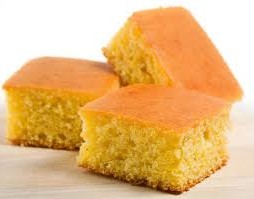 Depending upon the time of year, angle, and added reflectors, my solar oven can range from 275º F on a cold day near Christmas to well over 400º F on a warm summer day. Other than time spent cooking most foods are not affected by the cooking temperature. An exception is bread. If it is winter, I bake corn bread, if summer, whole wheat yeast bread.
Depending upon the time of year, angle, and added reflectors, my solar oven can range from 275º F on a cold day near Christmas to well over 400º F on a warm summer day. Other than time spent cooking most foods are not affected by the cooking temperature. An exception is bread. If it is winter, I bake corn bread, if summer, whole wheat yeast bread.
Food in a solar oven (or cooker with oven bag) begins to cook at 185º F. Normally, solar ovens and cookers approach 300º F degrees, more than hot enough to cook food. My solar oven and cooker takes about a half hour a pound to cook a chicken or other meat. Root vegetables about the same amount of time.
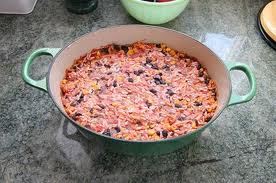 If I want beans and rice in a casserole, I cook the beans first in extra liquid then add the rice to finish off and absorb the remaining liquid. Solar cooking is very moist so water loss is minimal. Often I will use wild rice and toss it right in with everything else since it takes at least an hour to absorb water and is hard to over cook. In fact it is similar to something my mother used to do.
If I want beans and rice in a casserole, I cook the beans first in extra liquid then add the rice to finish off and absorb the remaining liquid. Solar cooking is very moist so water loss is minimal. Often I will use wild rice and toss it right in with everything else since it takes at least an hour to absorb water and is hard to over cook. In fact it is similar to something my mother used to do.
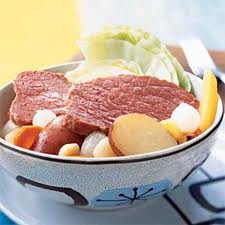 When I was a kid my mother would make what we considered authentic New England Boiled Dinners, mostly water, root vegetables, whole onions and a piece of meat. Into the pot it went and was boiled until done. One reason why she liked it was it kept on the stove. The dinner would stay warm on low and you could eat it anywhere over a several hour time span. Food cooked in a solar oven is very much the same way. It’s boiled dinner friendly. You can leave almost anything much longer in a solar oven than planned without having it over cook. That adds to the convenience.
When I was a kid my mother would make what we considered authentic New England Boiled Dinners, mostly water, root vegetables, whole onions and a piece of meat. Into the pot it went and was boiled until done. One reason why she liked it was it kept on the stove. The dinner would stay warm on low and you could eat it anywhere over a several hour time span. Food cooked in a solar oven is very much the same way. It’s boiled dinner friendly. You can leave almost anything much longer in a solar oven than planned without having it over cook. That adds to the convenience.
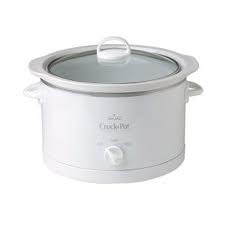 Just as one changes cooking styles for a crock pot, one changes them for a solar oven. Indeed, crock pot recipes work well in a solar oven. My oven will also do two pots at a time but the only time I might use two is for water for pasta. Usually I just plan on adding my pasta to the dish and letting it absorb what water it needs from the dish itself.
Just as one changes cooking styles for a crock pot, one changes them for a solar oven. Indeed, crock pot recipes work well in a solar oven. My oven will also do two pots at a time but the only time I might use two is for water for pasta. Usually I just plan on adding my pasta to the dish and letting it absorb what water it needs from the dish itself.
If one wants solar cooking can be cost effective, convenient, and fun. Since it is moist cooking and more gentle than a dry oven I think the food is more wholesome as well. The only down side I have run into is clouds that move in after I’ve started cooking. A look at the forecast solves that issue. Twice I’ve not checked the forecast and had clouds move in when my meal was half done. In those two instances I just finished them off in a conventional oven or microwave.
I have a commercially made oven, an oven I made out of a wooden box, a solar cooker made from a windshield reflector and a parabolic one made from an old beach umbrella. All work well. I haven’t covered solar fryers, which are big parabolic collectors and require sunglasses and constant attention but can fry (and burn food.) But, stand by… I am making one out of an old satellite dish and mylar.
Generally said the recipes below work for a lidded pot in a solar oven or in an oven bag in a solar cooker, or pot in an oven bag in a solar cooker. When ever “cooker” is mentioned the food must also be in an oven bag. Generally the solar oven or cooker should be redirected towards the sun every hour or so. Time of year, latitude and amount of solar collection influence slength of cooking. Usually one cooks between 9 a.m. and 3 p.m. with 10 a.m. and 2 p.m. being peak heat hours (solar time.) Many insist you use only black pots but I have done quite well with glass pots with glass lids, particularly in the oven bags while using the solar cooker. While I have changed the recipes the originals are by the courtesy of the Solar Oven Society.
This recipe, however, is mine. I take any hollow squash, butternut for example, and drill a small hole in it to let off steam. Then I put it in my solar oven, hole side up, for about three hours. They cook quite nicely. Next what I need to do is make a larger drill hole and pour in some honey and spices….
Baked Acorn Squash
* 1 acorn squash cut into 2 halves and seeded
* ½ tsp. fresh ground black pepper, or to taste
* ½ tsp. coarse salt, or to taste
* ½ tsp. ground cumin
* 2 tbs. butter
- 1.Place the 2 squash halves in one long cooking dish. 2. Divide the other ingredients evenly between the two squash halves. 3. Put lids on the black cooking pot(s) and place them in the Sport solar oven. Clip the clear lid to the oven. Face the oven into the sun and then rotate it clockwise 30 degrees. Relax and do other things. The squash can be left unopened the entire cooking time. Check doneness in 3 hours. Cooking time: 4 – 6 hours, serves 2 –4
Solar Baked Fresh Fish Fillets
Cooks quickly in 45 minutes to 75 minutes on clear day.
4 each, 1/2 pound, fresh fish steaks, 1–1½” thick (Fish fillets – any shell fish, tuna, salmon or any white meat fish.
The Sauce: 2 tbs. butter, 2 tbs. fresh lemon juice, 1 sprig of fresh, chopped, flat leafed parsley, salt and fresh ground pepper to taste
1. Place 4 fillets in a baking dish, put ¼ of the sauce ingredients on top of each fillet.
2. Cover the pot and place in solar oven/cooker. Face toward sun with the shadow directly behind the oven. Do not open the oven to check for doneness until 45 minutes have passed. Serves 4.
Baked Potatoes
This recipe is based on potatoes weighing 1 lb. each. For smaller potatoes the cooking time will be shorter.
* 2 lbs. bakig potatoes per pot
* 2 tbs. minced flat parsley per pot
* 2 tbs. minced fresh chives per pot
* fresh ground pepper and salt to taste
* butter or olive oil to taste
- 1.Wash and dry the potatoes. Prick each potato a few times. 2. Place half of the dry potatoes in each Sport cooking pot. Do not add liquid. 3. Put lids on the pots (black colored the best) and place them in the solar oven/cooker. The potatoes can be left unopened the entire cooking time. Check in 2 hours. 4. To serve, open the potatoes and sprinkle with the parsley and chives, add salt & pepper and butter to taste. Cooking Time – up to 6 hours, serves 4 – 6
Boneless, Skinless Chicken Breasts With Tomatoes, Olives and Capers
Cooks in 1 – 2 hours on clear day
* 4 each, boneless, skinless chicken breasts – about 2 lbs total
* 2 tbs. olive oil
* 1 sprig of fresh basil, chopped
* 4 oz of pitted and sliced kalamata olives packed in oil
* 2 oz capers, drained
* 14 oz of fresh or petit diced canned tomatoes, minced
* 8 tbs. olive oil
* salt and fresh ground pepper to taste
Make the Dish
Wash and dry the breasts on paper towels. Rub each piece on all sides with the olive oil. Place 2 tbs. of the olive oil in the bottoms of each of the pots and coat the entire bottoms. Add two breasts to each pot, divide the sauce ingredients between them and salt and pepper to taste. Pour 2 more tbs. of olive oil over the ingredients in each pot. Mix the contents of each pot well. Cover the pots. This dish will be done in 1 – 2 hours. Serve at once. Serves 4.
Pot Roast
One beef chuck or similar roast- about 3 lbs. Cut the meat into 2 or 3 chunks, put the roast into a pot. Empty one package of dry onion soup mix over the meat, cover, and cook in the solar oven for 4 to 6 hours at 200 to 250F, less if hotter, longer if cooler.
Baked Chicken
Take a three to four pound chicken, season with your favorites spices or use a zesty Italian dressing powder sprinkled all over it. You can put sliced potatoes under the chicken or around the top edge of the pot. On top they may brown a little, under the chicken that add flavor to the stock and come out like tasty boiled potatoes. Other sliced vegetables can be added as well. Cooking time two to three hours depending upon the conditions.


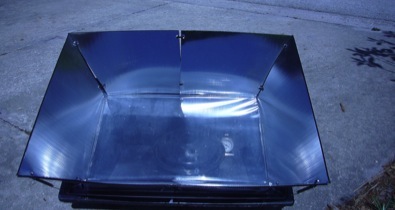

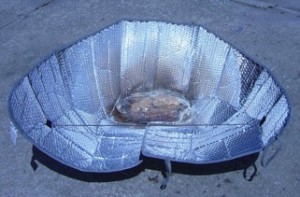


Great info! In your excellent video on solar cooking you added greens that were pre-cooked to the chicken dish. Did you pre-cook them because they shrink down and take up less space or is it to do with how long they must cook?
Thanks!
they were cooked wild greens I had on hand.
Hey Deane,
Solar Ovens are really easy to make too. I used a cardboard box for a long time, before upscaling to a lifoam cooler. Anyways, people are welcome to borrow my design. And I have lots of recipes I’ve tested.
http://www.funstainables.com/Splendy_solar_oven_recipes.htm
I’m not actively selling them anymore and I have stock on hand so if anyone is interested I’d sell them for cost plus shipping. Kim
Green,
I have heard, but do not know if it is true, that a large satellite dish can concentrate rf radiation at the focal point to the extent of causing x-ray like organ damage to people spending time near that part of the dish.
If true, would this pose a danger with certain solar ovens?
Thank you for the site- I hope not to waste your time with an urban legend and I’m curious what your thoughts are.
Great